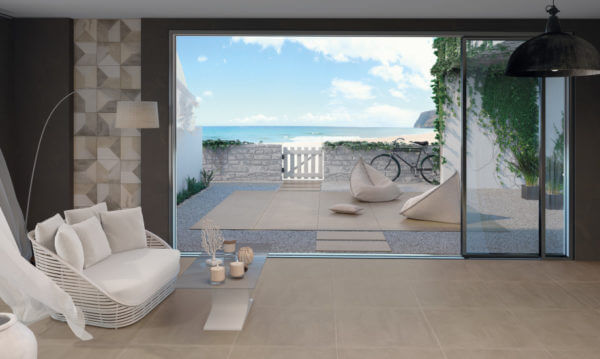Tiles are a very versatile option for modern interiors. Use it to create hardwearing flooring solutions, or create a fully enclosed tile area such as a patio, bathroom or kitchen. If you’re thinking of tiling your next space, here are some of the top FAQ’s you should consider to help you decide on the best options.
Why choose tiles?
Tiles have been around for thousands of years. In fact, the earliest use of decorative tiles was found in Egypt, dating from about 4000 BC. Not many things continue from one era to the next, so it’s important to consider why tiling is still a preferred option today.
Maintenance – What maintenance. Modern tiling options are pretty much maintenance free and will only need a good clean, mop or wipe down to maintain its good looks. (Side note: the more slip resistant a tile is, the harder it is to clean – that said it is still not hard to clean). This is one of the many benefits of tiling a room. It’s hardwearing, resistant to the elements and will most likely last you many many years.
Highly Durable – Tiles offer outstanding durability, even in high traffic areas. In fact, modern tiles are created to be stainproof, scratchproof, waterproof, and fire resistant. This means that its potential is endless.
Hypoallergenic – As a flooring solution, tiles offer a much more sanitary option when compared to carpets. Germs, bacteria and more do not hold up well on ceramic or porcelain tiled surfaces.
Where will you tile?
From the bathroom surrounds, to the kitchen floors, backsplash and more. Tiles are versatile and a great option in almost any space. Know where you will place your tiles before you head out in search of the right choice. This will help you determine what sort of tile you’ll need.
What’s the difference between floor and wall tiles?
Floor tiles and wall tiles are not equal. You may be able to use a floor tile on a wall, but we do not recommend using wall tiles on your floors.
Floor tiles are often created thicker and harder to withstand traffic, appliances and furniture etc. And most have added texture to reduce the risk of slips. Wall tiles, however, are often manufactured as a thinner, smoother and more delicate option. It’s also much slicker when it’s wet, which is why wall tile is not recommended underfoot.
Porcelain or Ceramic tiles?
The biggest difference between porcelain and ceramic tile is the rate at which these absorb water. Porcelain tiles absorb less than 0.5% of water. However, ceramic and other non-porcelain tiles will absorb more. This comes down to what goes into the production of porcelain tiles. The clay is typically denser and so less porous. This makes porcelain tile the perfect option in humid areas like the bathroom. Porcelain tiles are also hardwearing with incredible strength. Furthermore, these can be manufactured to imitate the look of natural materials, such as wood and stone, so they are increasingly used as an affordable alternative to the genuine thing.
Ceramic tiles are kiln-fired at a lower temperature than porcelain tiles, making them less dense, softer, and more porous. The clay used to make ceramic tiles is also less refined. This often means it is more affordable than porcelain. Many homeowners opt to install ceramic tiles as flooring, especially in warm climates, where the natural coolness of the tile becomes a welcome perk in the summer months.
How do I choose the right size of tiles?
Depending on your project, the size of your tiles may differ. So which size is best for which space?
As a general rule of thumb, choose tiles relative to the size of the room. A lrager space, like an open plan living area, would do well with large format tiles. Smaller areas, like a guest loo or backsplash will most likely handle smaller tiles better. Mosaics are another great option for small surface areas. As a pro tip, remember that your wall tiles should never be larger than their complimentary floor tile as this upsets the proportional look of a room.
How many tiles will I need?
Once you know the actual dimensions of the room, floor, or wall you plan to tile, you can then calculate how many tiles you will need. Many suppliers will provide costing per square metre or will give you the pricing for a box of tiles. Be sure to check which option is provided so you can properly calculate what you need. Remember to also take into account the spacing for grout. We also suggest adding 10% to account for any possible breakage.
Keep it Stylish
Stiles is a top tile retailer in South Africa and leaders in service, technical advice, creatie ability and innovative ideas. Furthermore, they support the local industry, artisans and artists from South Africa. Quality and style will always outweigh price when selecting products.
For more visit Stiles.




















